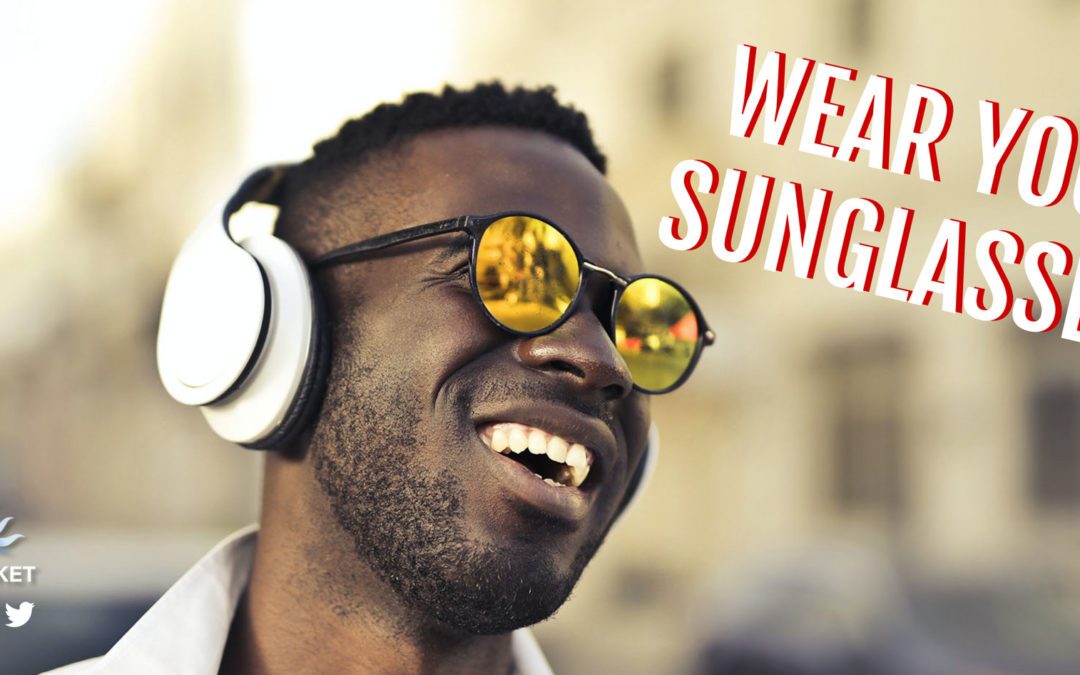How sunglasses protect your eyes
Introduction
Sunnies, shades, spekkies, glecks. What is in a name, right? Sunglasses may go by many names across the world, but their appeal is universal.
Sunglasses block out the nasty glare of the sun, and they help to make you look fabulous.
We can safely assume that sunglasses form an integral part of most peoples’ wardrobes, and they seem to reflect the style, age, and general outlook of the bearer.
Easy to make?
On the other side of the spectrum, some people think sunglasses are low-tech, unnecessary, and overpriced accessories that should be a cinch to make at home if you had the right equipment and the inclination to do so.
Think about it: you just pop dark, plastic lenses in a funky frame, and voila! You’ve got a pair of spekkies. If you’re the fancy type, pay extra for Polaroid lenses, and you’re in style, easy!
It’s not that simple.
Remember when running shoes evolved in the 1980s and personal computers developed in the ’90s? Spare a quick thought to your cell phone today and the way your 14-year-old cousin frowns at your outdated two-year-old phone.
Well, sunglasses have also advanced rapidly, and the odds are that the sunnies you’ve been wearing for the last decade are not just ‘last season,’ they’re downright Jurassic!
In this blog, we look at how sunglasses work to protect your eyes and how they are put together. First, however, to understand precisely how this all came to be, we need to look at a bit of history.
They’ve come a long way.
Neanderthal man sunglasses
Sunglasses have come a long way since the first ‘snow goggles’ were worn 2000 years ago.
Back then, shades were made from carved driftwood, bone, or walrus ivory. It sat snug on the face and had thin slits in the front for the Neanderthal man to see through.
There were no lenses and no UV protection. The ‘sunglasses’ was just an effort to reduce the amount of light that entered the eye to help the bearer cope with the glare of the snow. The cavemen crudely made it, but in those days, something had to better than nothing.
Over time, several other efforts were made to protect the eyes from the glare of the sun.
Roman Emperor Nero was famous for watching his gladiators train while ogling through polished gemstones. That sure must have been the most expensive sunglasses in history.
In the 12th century China the magistrates wore smoke-tinted quarts lenses. These were used to hide the emotions of the judge and not necessarily to protect the eyes. We are pretty sure many of us still use our trusty sunglasses for that very purpose when the need arises!
Prescription glasses
A new age
Once ophthalmologists designed prescription wire spectacles to improve eyesight, the age of modern sunglasses started.
Patients with syphilis had a problem with sunlight. It hurt their eyes. The founders of these first sunnies used yellow and brown-tinted glass in the frames to help these people.
Modern sunglasses only really became fashionable when film stars started wearing them in the 1920s for anonymity and hiding their red eyes caused by the klieg lamps used in the studios.
Polarized lenses
Then came polarized lenses, invented in the 1930s by Edwin H. Land and used predominately in aviation. Suddenly pilots had something to protect them against the glare of the sun and possible fatal mistakes.
Pilots used sunglasses extensively in the Second World War, but when Tom Cruise wore his Ray-Ban’s in the movie Top Gun, shades became the rage. Sunglasses were definitely here to stay!
Why do we wear sunglasses?
Let us count the ways.
Today, sunglasses serve several purposes. Not only are they fashion items, but they ease the strain on your eyes. In addition, sunglasses also protect from the harmful rays of the sun. The great irony is that this last fact is probably the least appreciated but most important feature of modern sunglasses.
UV rays
Sunglasses protect your eyes from harmful ultraviolet (UV) rays emitted by the sun. There are two types of UV rays: UVA causes premature aging and skin cancer, and UVB causes sunburn.
Just like these ultraviolet rays damage and age your skin, both can damage your eyes. But, you are not safe, even while lounging in the shade! Light will still reach you, and reflected light still contains UV rays that are harmful – there’s no place to hide!
This is what sunglasses can do.
It protects against ‘sunburn’ of your eyes.
Ever return from a day in the sun with painful red skin and a high temperature? Well, just like your body gets a sunburn now and then, so can your eyes.
The watery, scratchy, gritty, dry eyes after a day out can point to a sunburned cornea and a condition called ‘photokeratitis.’
Fortunately, it will clear up in a day or two, though chronic overexposure to UV light will increase your odds of developing cataracts and increase your risk of macular degeneration. The World Health Organisation states that 20% of all cataracts are caused by overexposure to the ultraviolet rays from the sun.
So, how do sunglasses work?
We gave you a few clues until now, but now, at last, we get to the nitty-gritty of how sunglasses work. Today’s best sunglasses are made up of multiple elements that all play a role in protecting your eyes.
The elements of sunglasses
Not all sunglasses are equal. Some will have more than one feature to protect the eyes, whereas others focus on one selling point. A general rule of thumb is that the more expensive the pair of sunglasses are, the more qualities it will have.
- UV Coating: We told you about the harmful UV sun rays. UV coating, therefore, is an essential feature of any pair of sunglasses. There are two types: plastic lenses require a coat, whereas polycarbonate lenses have UV protection built-in.
- Anti-reflective coating: Anti-reflective coating eliminates irritating reflections from the back surface of the sunglasses.
- Tints and mirror coating: This coating acts as a mirror and is the first line of defense in mirror sunglasses. It reflects light away from those precious eyes and will relieve squinting.
Mirror coatings come in several colors, with different tinting options responsible for different effects. For example, amber mirror-coated sunglasses will give a sharp definition. A green layer will reduce glare and increase contrast, whereas a grey coating will cause the least color distortion.
- Polarized lenses: Reflected light that shines off surfaces such as asphalt, snow, water, and sand is called polarized light. The glare experienced from this type of light is due to the jamming of the light waves as they vibrate in the same plane. Polarized film on the sunglasses lens only allows vertically polarized light to pass through, thereby effectively removing the glare. Polarized lenses are ideal for drivers, snow skiing, and water-based activities where harsh surfaces reflect the light.
Choose your next pair of sunglasses.
Start the protection now.
They say that it’s never too late or too early to start protecting your eyes. So, apart from the obvious fit, remember the following four rules when you next buy a new pair of sunglasses.
- Rule one – UV protection.
A good pair of sunglasses acts as a good ‘sunscreen’ and will block more than 99% of the harmful UV rays. Few of us will spend a day in the sun without rubbing the factor 30 repeatedly on our skin, so why venture out without jacking up the eye protection? You owe it to your eyes to protect them.
- Rule two – Choose your lens.
Sunglass lenses are made of glass, plastic, or polycarbonate. Here individual preference applies.
- Rule three – Polarization.
The absolute best sunglasses have polarized lenses. They are usually more expensive but certainly worth the effort if you plan on spending a lot of time on the ski slopes or fishing for marlin in the deep sea.
- Rule four – Size does matter.
When it comes to your sunglass frames, size does matter! The bigger, the better, as larger frames cover a more significant portion of your face and will cause less harmful and pesky light to seep in around the edges.
Conclusion
A sunglasses myth
There is a general myth about sunglasses that says that ‘darker is always better.’ It is untrue. Clear transparent lenses can also offer 100% ultraviolet protection.
Just like thin latex gloves provide much more protection than thicker woolly mittens during surgical procedures, so does the UV coating block unwanted ultraviolet light much more effectively than a ‘dark’ lens.
The only thing a dark lens is good for is if you want to eyeball your crush on the beach unobtrusively. But, unfortunately, it will not give good and solid protection to your eyes.
To preserve your sight and enjoy good eye health for many more years, get a pair of sunnies that provides good UV protection, cover a large portion of your face, and enhances your features to boot. That is how sunglasses protect your eyes!
Resources
https://www.howitworksdaily.com/how-do-sunglasses-protect-your-eyes/
https://www.medexpress.com/blog/better-health/how-sunglasses-protect-your-eyes.html
https://artsandculture.google.com/theme/the-evolution-of-sunglasses/AwICKXCQPV3VKg?hl=en
https://www.allaboutvision.com/sunglasses/sunglasses-sunnies-shades/



Recent Comments